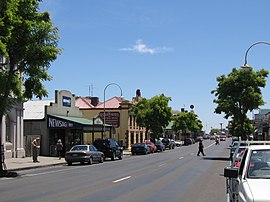Kilmore, Victoria
| Kilmore Victoria | |||||||||||||||
|---|---|---|---|---|---|---|---|---|---|---|---|---|---|---|---|
 The main street of Kilmore | |||||||||||||||
| Population | 6,678 (2011 census)[1] | ||||||||||||||
| Postcode(s) | 3764 | ||||||||||||||
| Elevation | 370 m (1,214 ft) | ||||||||||||||
| Location | |||||||||||||||
| LGA(s) | Shire of Mitchell | ||||||||||||||
| State electorate(s) | Euroa | ||||||||||||||
| Federal division(s) | McEwen | ||||||||||||||
| |||||||||||||||
Kilmore (/ˈkɪlmɔːr/, locally [ˈkɪlmoː])[2] is a town in the Australian state of Victoria. Located 60 kilometres (37 mi) north of Melbourne, it is contentiously claimed as Victoria's oldest inland settled town.[3] At the 2011 census, Kilmore had a population of 6,678.[1]
History
Kilmore Post Office opened on 1 February 1843 and, with Ovens (later Wangaratta) which opened the same day, were the fifth and sixth to open in the Port Phillip District and the first two inland offices.[4]
Kilmore was a stronghold of early Celtic settlers from Ireland, Scotland and Cornwall, and remains a strong Celtic area to this day. In the mid-1850s Kilmore was the electorate of the Irish-born Premier of Victoria (1857–59), John O'Shanassy (1818–83). O'Shanassy, an Irish Catholic, was the bane of the Protestant establishment in Melbourne and this also affected those who lived in Kilmore. O'Shanassy's supporters were referred to as 'O'Rowdies' and O'Shanassy as the 'Rowdy King".[5] A Melbourne Punch cartoon "Freedom of Election at Kilmore" depicted the 1859 election day in the town as a wild barney of Irishmen.[6][7] The town hosts a market on the last Saturday of each month, and a Celtic Festival each June.
Many of Kilmore's oldest extant buildings are made of bluestone including the hospital, old court house, former post office, some churches, a gaol, and a monument to Hume and Hovell near the golf course.

Public Transport
Kilmore is serviced by a V-Line Passenger train service on the Seymour / Shepparton Line.
The locality is also serviced by Mitchell Transit - providing a Town Bus route and intra municipal service covering the towns of Wallan, Kilmore, Broadford and Seymour within the Mitchell Shire.
Railway

A railway used to ascend from Heathcote Junction on the Sydney–Melbourne line, passed through Kilmore[8] with the main branch running onto Heathcote; while a white elephant branch line ran out to Lancefield until dismantled during 1914. The Heathcote branch line was closed in 1969 and then dismantled. An operational tram museum utilises part of the old railway right of way between Kilmore and Bylands.[9] Still today, many parts of the track are still in place like the old cobblestone platform of the original railway station. Most of this though has been built over or grown over.
Kilmore is served by a railway station at Kilmore East, on the main line. The Post Office at Kilmore East opened on 1 September 1872 as Gavan Duffy and was renamed Kilmore East two months later and closed in 1976.[4]
Media
Though Kilmore is located relatively close to Melbourne, it still retains the "Township" atmosphere. It is serviced by Melbourne radio and Television, and also offers local media services.
Newspaper - North Central Review
Radio - 98.3 OKR FM (Community Radio), and 87.6 FM Hit Radio (Narrowcast)
Education
The town has two private secondary schools and two primary schools; Kilmore Primary School, St Patrick's Primary school, Assumption College, and the Kilmore International School. The Kilmore International school (TKIS) is the only school in Australia to exclusively use the International Baccalaureate and not offer a local high school qualification such as the VCE.[10] The Australian Training College is also based in Kilmore and has been operating since 1994 delivering a range of nationally accredited courses including hospitality, management, training and assessment, horticulture to name a few.
Notable People
- Johnny Gilbert, bushranger, member of Ben Hall's gang
- John O'Shanassy, Premier of Victoria
- Lieutenant Leslie Maygar, Victoria Cross recipient in WW1
References
- ^ a b Australian Bureau of Statistics (31 October 2012). "Kilmore (State Suburb)". 2011 Census QuickStats. Retrieved 18 November 2012.
- ^ Macquarie Dictionary, Fourth Edition (2005). Melbourne, The Macquarie Library Pty Ltd. ISBN 1-876429-14-3
- ^ "Kilmore". The Sydney Morning Herald. 8 February 2004. Retrieved 17 September 2009.
- ^ a b Premier Postal History, Post Office List, retrieved 11 April 2008
- ^ O'Brien, Antony. Shenanigans on the Ovens Goldfields; the 1859 election, Artillery Publishing, Hartwell, 2005. (detail on O'Shannasy, the local member and Premier)
- ^ Punch, 8 September 1859, p.52
- ^ O'Brien, Antony. Shenanigans on the Ovens Goldfields; the 1859 election, Artillery Publishing, Hartwell, 2005. (detail on O'Shannasy, the local member and Premier). p. 81
- ^ The Heathcote Junction to Bendigo and Associated Railways Turton, Keith Australian Railway Historical Society Bulletin, April, 1970 pp69-88
- ^ Tucker, Maya V. Kilmore on the Sydney Road, Shire of Kilmore, 1988. (comprehensive (1830s–1980s) history based on local newspapers)
- ^ The Kilmore International School

